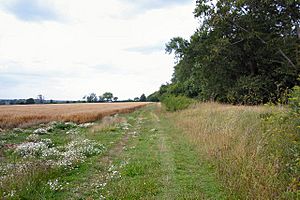Black Ditches, Cavenham facts for kids
| Site of Special Scientific Interest | |

Black Ditches, southern section
|
|
| Area of Search | Suffolk |
|---|---|
| Coordinates | 52°17′27″N 0°35′55″E / 52.2908°N 0.5985°E |
| Interest | Biological |
| Area | 1.6 hectares |
| Notification | 1984 |
| Location map | Magic Map |
The Black Ditches is an ancient earthwork located near the village of Cavenham in Suffolk, England. Part of this earthwork is a special protected area known as a biological Site of Special Scientific Interest (SSSI).
This long ditch and bank stretches for about 4.5 miles (7.2 km). It runs between the River Lark near Lackford and an old road called the Icknield Way. Experts believe it was built after the Roman times, but its exact age is still a mystery.
Today, you can still see two main parts of the Black Ditches. One section is to the north-east of Cavenham, and the other is to the south-east. A section about 730 yards (670 meters) long, south of Cavenham, is the protected SSSI area. It's important to know that there are no public paths directly onto the Black Ditches.
Contents
Uncovering the Past: The History of Black Ditches
Historian Cyril Fox believed that the Black Ditches was the most eastern of five important earthworks. These earthworks were built to defend the ancient kingdom of the Wuffings in East Anglia, along the Icknield Way. The other earthworks are known as the Cambridgeshire Dykes, which include Devil's Dyke, Fleam Dyke, Bran Ditch, and Brent Ditch. The Black Ditches is not as well preserved as these western defences.
What Did Digging Reveal?
In 1992, a small archaeological dig took place at the Black Ditches. This excavation showed that the earthwork actually had a ditch on both sides of its central bank. The only items found during this dig were pieces of pottery from the Iron Age.
How Long Are the Ditches?
The total length of the Black Ditches is around 4.5 miles (7.2 km). It stretches from south of Cavenham towards Icklingham. However, there is no evidence that the ditch ever crossed the River Lark at Icklingham. The Icknield Way crosses the line of the ditch in the middle section. In this central area, the ditch is usually no longer visible.
Northern and Southern Sections
The northern part of the ditch that remains is about 0.65 miles (1.05 km) long. It runs across the eastern edge of Cavenham Heath towards the River Lark. This section is not as well preserved, but in some places, it can still be up to 1.75 meters (5.7 ft) high and 8 meters (26 ft) wide. This northern part is not an SSSI, but it is next to the Breckland Farmland SSSI.
The southern part of the ditch is longer, about 1.25 miles (2.01 km) long. It extends southwards across Risby's Poor Heath. This section forms the border between Cavenham and Lackford parishes before it enters Risby parish further south.
Nature's Treasures: Plants and Wildlife
The Site of Special Scientific Interest (SSSI) at Black Ditches covers the southern section of the earthwork. This protected area is about 1.7 hectares (4.2 acres) in size. It is next to another SSSI called the Breckland Farmland SSSI.
A Special Habitat
The banks of the Black Ditches are a great example of chalk grassland. This type of grassland is very special and supports many different plant species. The site is particularly well preserved because it is thought that it has never been ploughed. This means the soil and plants have been undisturbed for a very long time.
What Plants Grow Here?
You can find a wide variety of plants at Black Ditches. The main types of grass include Crested Hair-grass (Koeleria cristata), Timothy Grass (Phleum pratense), and Common Quaking-grass (Briza media). There are also interesting herb species, like the rare Heath Sedge (Carex ericetorum) and Bastard Toadflax (Comandra umbellata). Along the edges of the ditch, where it is protected by nearby trees, some scrub plants have also grown.

